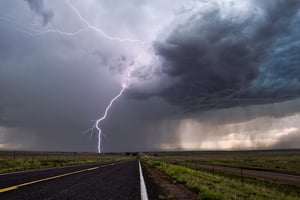
Summer in the Midwest means longer days, hotter temperatures, and – in some cases – severe thunderstorms.
If you’re familiar with severe weather, you likely know what to do if you’re at home: Go to the basement or into a bathroom and wait it out. But, what if severe weather strikes while you’re at the workplace?
As summer continues on, it’s important for employers or building managers to have a plan in place in case of severe weather during the workday, as well as for all employees to have a personal safety plan so they know what to do if a tornado strikes, wherever they are.
Have a weather safety system in place
Severe thunderstorms and tornadoes don’t often appear out of nowhere. Usually, there’s some warning, even if that warning time is only about 9 minutes. In the case of a tornado, that 9 minutes is crucial. This gives employees time to get to a safe place to wait out the storm.
One of the best ways to stay on top of severe weather is to have an emergency weather radio. This radio stays on all the time, and it only goes off if there’s a severe weather event, making sure you know about the incoming weather as soon as possible. Many smartphones also automatically set off alarms in the case of a tornado warning or other severe weather event, depending on the phone’s settings.
After you know severe weather is coming, the next step is letting everyone in the building know. If you have a professional fire and life safety system, those communication components can also often be used in the case of severe weather. Using PA system announcements and/or alarms, you can make sure everyone is aware of the situation as quickly as possible.
Plan and practice
For any building manager or employer, the next step is to make sure that everyone knows what to do in the case of severe weather.
Drills should be practiced ideally every few months, or at least twice a year. Signage should be posted around the building with what to do in the case of severe weather, including safe locations to shelter and what to do after the storm has passed, whether that be to evacuate or await further instructions.
It can be helpful to assign safety leaders in each area who are responsible for making sure everyone is accounted for in a severe weather emergency. These people can be charged with making sure everyone is aware of the weather event, conducting head counts once everyone has reached the shelter, and ensuring evacuation procedures are followed after the weather has passed. If this method is utilized, make sure that everyone knows who their safety leader is, and that the safety leader knows who exactly they are in charge of.
Know what to do
While all organizations should make sure to have official weather policies in place, it’s also important that employees take it upon themselves to stay weather aware.
One of the best things you can do to protect yourself from severe weather wherever you are is to make sure your phone is set up to provide you weather alerts. By doing this, you know that your phone will sound an alarm if a tornado watch or warning is issued, letting you know as soon as it happens.
Another simple thing you can do is just to stay aware of your surroundings. Tornadoes are typically proceeded by noticeable changes outside, including:
-
A greenish tint to the sky
-
Hail, particularly if it occurs with a tornado watch or warning already in effect
-
Clouds that move very quickly or appear to rotate in the sky
-
A rushing sound, similar to a train or jet
-
An obvious funnel-shaped cloud that you can see, either in the sky or already down to the ground
If a tornado warning is issued or you see the signs listed above, the best course of action is to seek shelter. If your employer has specific steps to follow, be sure to follow those. If, however, you find yourself in a situation without clear guidance or are in an unfamiliar building, you can do the following:
-
Find a small interior room without windows, if possible
-
Go under a desk or other stable piece of furniture
-
Sit with your knees tucked under you, and bend over while lacing your fingers together and placing them over the back of your neck
-
Keep your phone nearby, and continue to shelter until you are sure that the weather has passed and the tornado warning has expired
If you’re outside or in a vehicle, the best thing to do is to get to a safe building or drive to a shelter if possible. If that’s not possible, the next best thing is to find a low-lying area or ditch and cover your head and neck until the weather has passed.
Life safety is among the most important responsibilities for any building manager or business owner. Working with a professional fire and life safety company can help you feel confident that you’re providing your property and people with the best protection possible, even if severe weather strikes.

